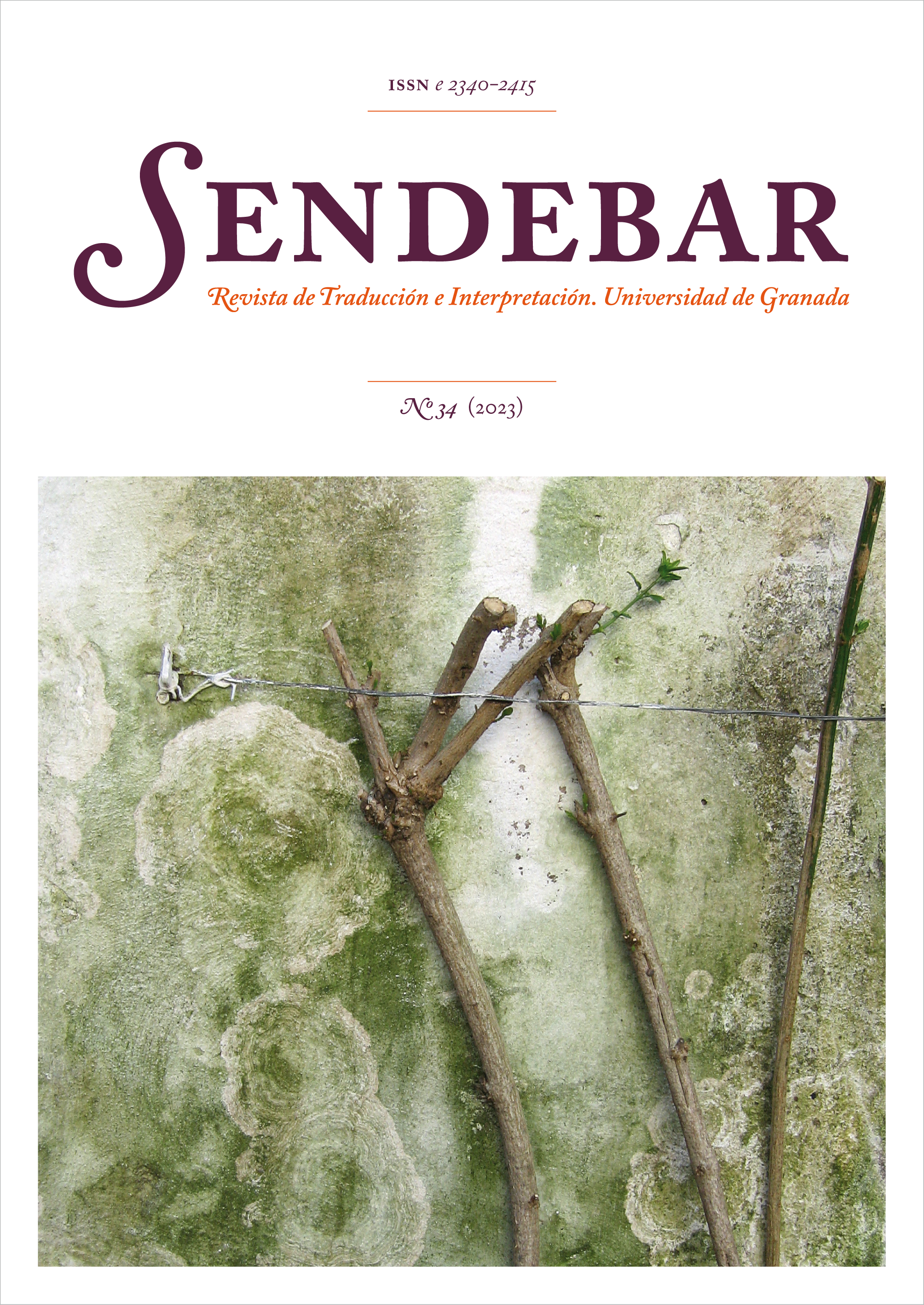Aproximación a la traducción de términos bélicos de la China antigua: armas en Romance de los Tres Reinos
DOI:
https://doi.org/10.30827/sendebar.v34.26255Palabras clave:
términos bélicos, Romance de los Tres Reinos, traducción chino-español, glosarioResumen
Las abundantes guerras en la China antigua suelen conllevar importantes desarrollos en la cultura así como nuevos elementos bélicos: armas, atuendos militares, y artilugios y estratagemas de combate. El objetivo del presente trabajo es estudiar cómo se traducen los términos bélicos de la China antigua tomando las armas en Romance de los Tres Reinos como ejemplo. Valiéndonos de un corpus paralelo ad hoc, hemos escogido ejemplos que contienen las armas más frecuentes de la obra y los hemos analizado partiendo de la teoría traductológica de Newmark (2001a, 2001b), a saber, la traducción semántica y la traducción comunicativa. El resultado apunta a que son dos métodos complementarios. Finalmente, hemos elaborado un glosario que permite visualizar las armas estudiadas y sus posibles traducciones, lo que podría ser de provecho para aquellos estudiosos que quieran traducir al español obras clásicas de China.
Descargas
Citas
Allevi, A. (Trad.). (S.f.). Romance de los Tres Reinos. (Solamente es una versión digital para Kindle disponible en https://www.amazon.es/)
Baker, M. (1995). Corpora in translation studies: an overview and some suggestions for future research. Target 7, 223-243. DOI 10.1075/target.7.2.03bak.
Brewitt-Taylor, C. H. (Trad.). (2011). Romance of the Three Kingdoms. Tuttle Publishing.
Cebrián Salé, R. (Trad.). (2014). Romance de los Tres Reinos, Vol. I. Createspace Independent Publishing Platform.
Cui, Y. (崔洋). (2019). Translation Strategies for Terminology Pertaining to Ancient Chinese Warfare: A Case Study of Three Complete English Versions of Romance of the Three Kingdoms (Sanguo Yanyi) (林语堂忠实理论视角下中国古代战争领域术语的翻译策略研究——以《三国演义》的三个英文全译本为例). Trabajo de fin de máster, Universidad de Estudios Extranjeros de Beijing, Beijing, China.
Dohrenwend, R. E. (2007). La lanza: un arma efectiva desde la antigüedad. Revista de Artes Marciales Asiáticas, 2(2), 8-35.
Du, W. (杜文玉), Wang, Y. (王颜), Liu, P. (刘鹏), Wei, S. (魏顺兰). (2007). Tushuo Zhongguo Gudai Bingqi yu Bingshu (图说中国古代兵器与兵书) [Una historia ilustrada de armas y libros de guerra en la China antigua]. World Publishing Corporation.
Hu, K. (胡开宝). (2011). Yuliaoku Fanyixue Gailun (语料库翻译学概论) [Introducción a estudios de traducción basados en corpus]. Shanghai Jiaotong University Press.
Liao, Q. (廖七一). (2001). Contemporary Translation Studies in UK (当代英国翻译理论). Hubei Education Press.
Luo, G. (罗贯中). (1989). Sanguo Yanyi Mao Zonggang Pingben (三国演义毛宗岗评本) [Romance de los Tres Reinos con comentarios y modificaciones de Mao Zonggang]. Shanghai Guji Chubanshe.
McEnery, T. & Oakes, M. (1996). Sentence and word alignment in the CRATER project. Using corpora for language research, 211-231.
Newmark, P. (2001a). A Textbook of Translation. Shanghai Foreign Language Education Press.
Newmark, P. (2001b). Approaches to Translation. Shanghai Foreign Language Education Press.
Ortega, M. T. & Pérez, O. M. (Trad.). (2012). Romance de los Tres Reinos. Ediciones en Lenguas Extranjeras Cía. Ltda.
Roberts, M. (Trad.). (1994). Three Kingdoms. Beijing Foreign Languages Press.
Rovira-Esteva, S., Casas-Tost, H., Fustegueres i Rosich, S., Qu, X. & Vargas-Urpi, M. (2015). Guía de estilo para el uso de palabras de origen chino. Adeli Ediciones.
Sánchez Ramos, M. del M. (2019). Corpus paralelos y traducción especializada: ejemplificación de diseño, compilación y alineación de un corpus paralelo bilingüe (inglés-español) para la traducción jurídica. Lebende Sprachen, 64(2), 269–285. doi:10.1515/les-2019-0015.
Sun, W., Kozlova, I., & Chang, F. (2022). Hacia estudios traductológicos del chino clásico: elaboración de un corpus paralelo chino clásico-español. ALPHA: Revista de Artes, Letras y Filosofía, 1(54), 157-178. doi:10.32735/S0718-22012022000541030.
Wang, K. (王克非). (2004). Shuangyu Duiying Yuliaoku: Yanzhi yu Yingyong (双语对应语料库: 研制与应用) [Corpus paralelo bilingüe: diseño y aplicación]. Foreign Language Teaching and Research Press.
Wang, Z. (王兆春). (1996). Zhongguo Gudai Bingqi (中国古代兵器) [Las armas en la China antigua]. The Commercial Press.
Wei, L. (魏丽娜). (2017). Etymological Tracking and Translation Analysis of Military Terms in Shi Ji and Han Shu within the Framework of Knowledge Transfer (知识传播框架下《史记》《汉书》军事术语的语义溯源与翻译研究). Trabajo de fin de máster, Universidad de Tecnología de Dalian, Dalian, China.
Xiang, S. (向士旭). (2018). Jiyu yuliaoku de Sunzi Bingfa bingxue shuyu yingyi yanjiu (基于语料库的《孙子兵法》兵学术语英译研究) [Estudio basado en corpus sobre la traducción al inglés de términos de ciencia militar en El arte de la guerra]. Liuzhou Zhiye Jishu Xueyuan Xuebao (柳州职业技术学院学报), 4, 90-97.
Yang, H. (杨泓),Yu, B. (于炳文),Yin, J. (殷稼),Li, L. (李力) & Jiang, J. (蒋健). (1992). Huashuo Shiba Ban Wuyi-Zhongguo Gudai Bingqi Zongheng Tan (话说十八般武艺——中国古代兵器纵横谈) [Las dieciocho artes marciales- reflexión sobre armas de la China antigua]. Renmin Tiyu Chubanshe.
Yang, X. (杨向东). (2003). Textual Research on Eighteen Types of Feat in China (十八般武艺考述). Journal of Beijing University of Physical Education, 26(1), 28-29.
Zhang, F. (张帆). (2015). Zhongguo Gudai Jianshi (中国古代简史) [Breve historia de la China antigua]. Peking University Press.
Zhu, S. (朱绍侯), Qi, T. (齐涛) & Wang, Y. (王育济). (2010). Zhongguo Gudai Shi (中国古代史) [Historia de la China antigua]. Fujian People’s Publishing House.
Real Academia Española. Diccionario de la lengua española, 23.ª ed., [versión 23.5 en línea]. <https://dle.rae.es> [16-07-2022]
Rovira-Esteva, S., Casas-Tost, H., Tor-Carroggio, I. & Vargas-Urpi, M. (2019). La literatura china traducida en España. [Base de datos en acceso abierto en línea]. Disponible en: https://dtieao.uab.cat/txicc/lite. doi: 10.5565/ddd.uab.cat/214778.
Descargas
Publicado
Cómo citar
Número
Sección
Licencia
Derechos de autor 2023 Wei Sun

Esta obra está bajo una licencia internacional Creative Commons Atribución-NoComercial 4.0.
Terminos de Licencia Sendebar.

















